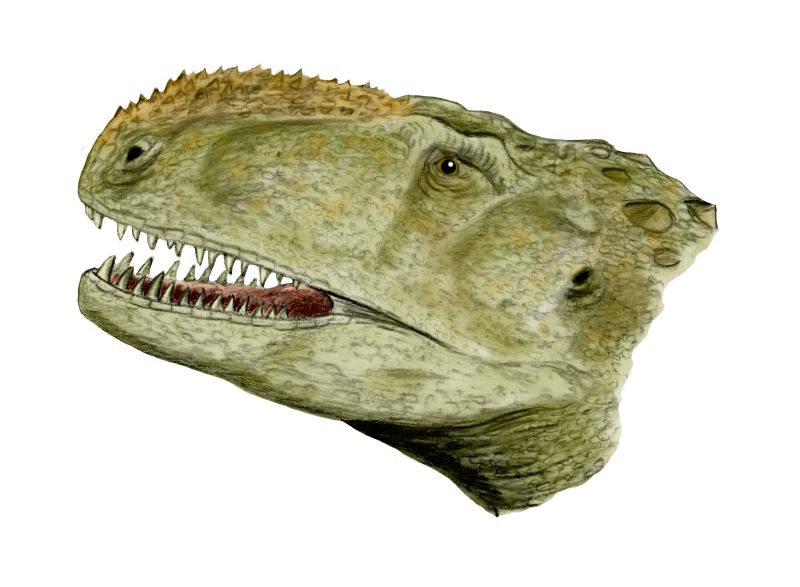- Abelisaurus
Taxobox
name = "Abelisaurus"
fossil_range =Late Cretaceous

image_size = 200px
image_caption = Profile of "Abelisaurus comahuensis".
regnum =Animal ia
phylum = Chordata
classis = Sauropsida
superordo =Dinosaur ia
ordo =Saurischia
subordo =Theropoda
infraordo =Ceratosauria
familia =Abelisauridae
genus = "Abelisaurus"
genus_authority = Bonaparte & Novas, 1985
subdivision_ranks =Species
subdivision =
* "A. comahuensis" Bonaparte & Novas, 1985 (type)"Abelisaurus" (pronEng|əˌbɛlɨˈsɔrəs; "Abel's lizard") is a
genus ofabelisaurid theropod dinosaur from the LateCretaceous Period of what is nowSouth America . It was abiped alcarnivore that probably reached 7 to 9meters (25 to 30 feet) in length, although it is known from only one partialskull .The generic name recognizes Roberto Abel as the discoverer of the specimen and former director of the provincial Museum of
Cipolletti inArgentina , where the specimen is housed. It also incorporates the Greek "σαυρος"/"sauros", meaning 'lizard'. There is one namedspecies , "A. comahuensis", which honors theComahue region of Argentina, where the fossil was found. Both genus and species were named and described by Argentinepaleontologists Jose Bonaparte andFernando Novas in 1985, who placed it in the newly-created family Abelisauridae.Bonaparte, J.F. & Novas, F.E. 1985. ["Abelisaurus comahuensis", n.g., n.sp., Carnosauria of the Late Cretaceous of Patagonia.] "Ameghiniana". 21: 259-265. [In Spanish] ]Classification
Many other abelisaurids have since been discovered, including extremely complete specimens of "
Aucasaurus ", "Carnotaurus " and "Majungasaurus ". Some scientists place "Abelisaurus" as a basal abelisaurid, outside the subfamily Carnotaurinae.Tykoski, R.S. & Rowe, T. 2004. Ceratosauria. In: Weishampel, D.B., Dodson, P., & Osmolska, H. (Eds.) "The Dinosauria" (2nd edition). Berkeley: University of California Press. Pp. 47-70.] Sereno, P.C., Wilson, J.A., & Conrad, J.L. 2004. New dinosaurs link southern landmasses in the Mid-Cretaceous. "Proceedings of the Royal Society of London: Biological Sciences" 271: 1325-1330.] Others are less certain of its position.Sampson, S.D., Witmer, L.M., Forster, C.A., Krause, D.A., O'Connor, P.M., Dodson, P., Ravoavy, F. 1998. Predatory dinosaur remains from Madagascar: implications for the Cretaceous biogeography of Gondwana. "Science" 280: 1048-1051.] Lamanna, M.C., Martinez, R.D., & Smith, J.B. 2002. A definitive abelisaurid theropod dinosaur from the early Late Cretaceous of Patagonia. "Journal of Vertebrate Paleontology". 22(1): 58-69.] Abelisaurids share some skull features with the unrelated carcharodontosaurids and, since "Abelisaurus" is known only from a skull, future discoveries may show that this genus was in fact a carcharodontosaurid.Novas, F.E. 1997. Abelisauridae. In: Currie, P.J. & Padian, K.P. "Encyclopedia of Dinosaurs". San Diego: Academic Press. Pp. 1-2.] However, this is thought unlikely.Fossil material
The one known
fossil skull of "Abelisaurus" is incomplete, especially on the right side. It is also missing most of thepalate (roof of the mouth). Despite the missing pieces, it is over 85centimeters (33inch es) long. Although there are no bony crests or horns, like those found in some other abelisaurids, such as "Carnotaurus", rough ridges on the snout and above the eyes might have supported some kind of crest made out ofkeratin , which wouldn't have become fossilized. There are also very large "fenestrae" (window-like openings) in the skull, which are found in many dinosaurs and reduce skull weight.Disputed age
"Abelisaurus" is one of the many dinosaurs that have been discovered in
Patagonia . It was originally described as coming from theAllen Formation but subsequent research proved the remains were actually found in the olderAnacleto Formation (part of the Neuquén Group) ofRio Negro Province , Argentina. The Anacleto is ageologic formation in South America, dating from the earlyCampanian stage of theLate Cretaceous Period, between 83 and 80million years ago .Leanza, H.A., Apesteguia, S., Novas, F.E., & de la Fuente, M.S. 2004. Cretaceous terrestrial beds from the Neuquén Basin (Argentina) and their tetrapod assemblages. "Cretaceous Research" 25(1): 61-87.]References
External links
* [http://www.nhm.ac.uk/jdsml/nature-online/dino-directory/detail.dsml?Genus=Abelisaurus "Abelisaurus" in the Dino Directory]
* [http://www.dinodata.org/index.php?option=com_content&task=view&id=6090&Itemid=67 "Abelisaurus"] at DinoData
Wikimedia Foundation. 2010.
